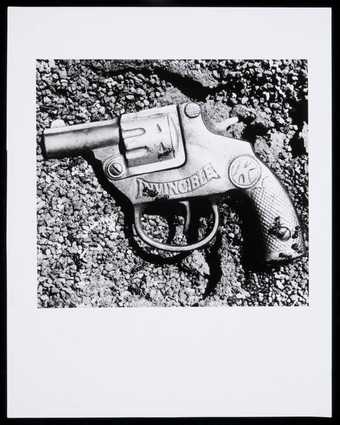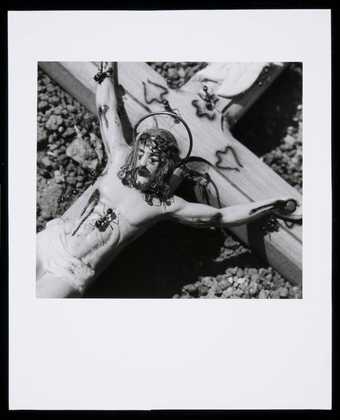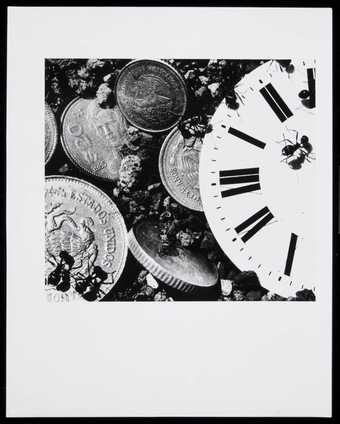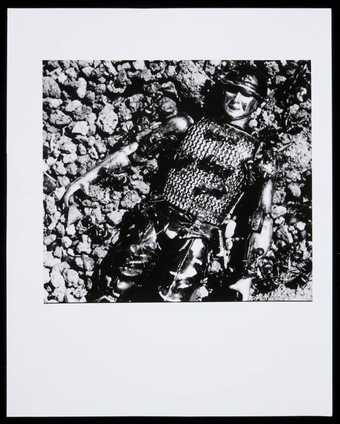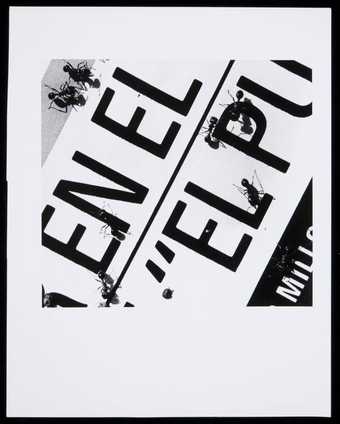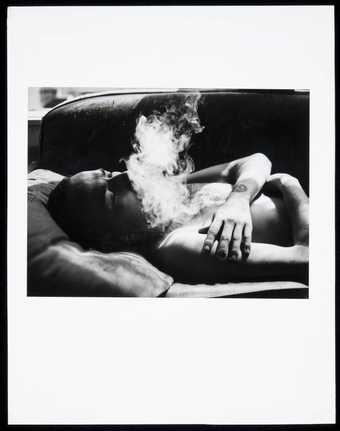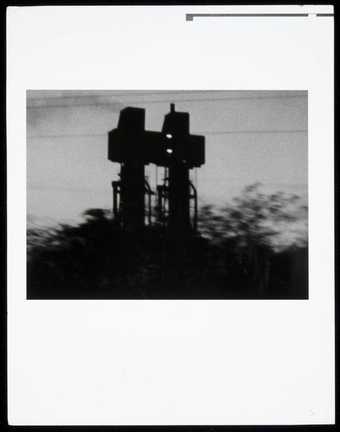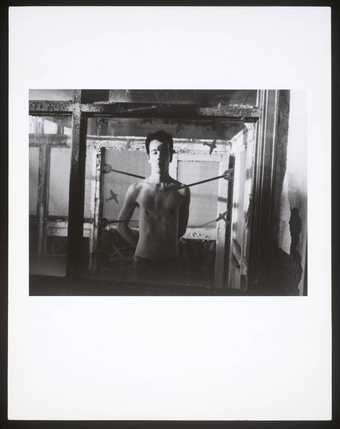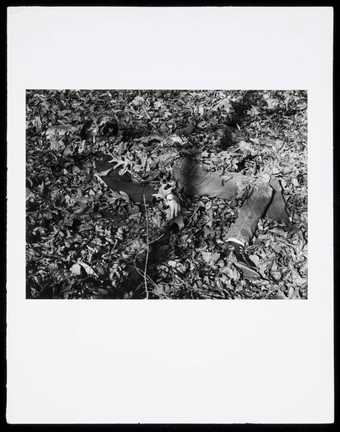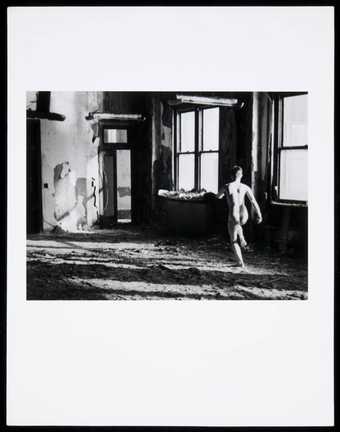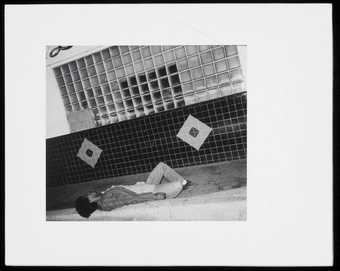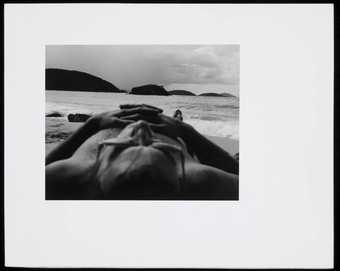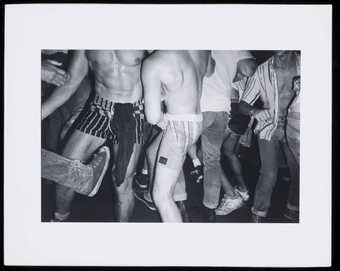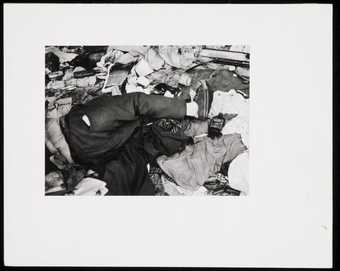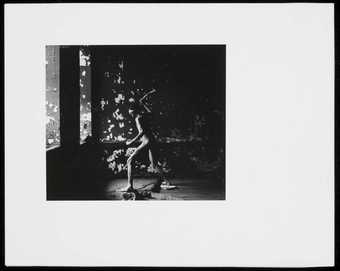
In Tate Britain
Prints and Drawings Room
View by appointment- Artist
- David Wojnarowicz 1954–1992
- Part of
- Ant Series
- Medium
- Photograph, gelatin silver print on paper
- Dimensions
- Image: 303 × 333 mm
- Collection
- Tate
- Acquisition
- Purchased 2010
- Reference
- P79852
Summary
Ant Series is a group of six black and white photographs depicting different subjects, all of which appear to have black ants crawling over them. These subjects include an effigy of Christ on the cross, a nude male body seen from the shoulders to the knees, a gun, coins and part of a clock face, a model soldier, and part of a sign with fragments of its text visible. The ants appear at different scales – for example, on the nude man they are disproportionately large, whereas on the gun they seem close to actual size. The ants project distinct shadows and they tend to face in different directions, as if in motion. The photographs are closely cropped such that their subjects are rarely wholly visible within the frames. This exclusion of spatial context, as well as the varying sizes of the ants, produces distortions of scale across the six photographs. The images all present distinct contrasts of light and dark and several feature gravel surfaces. The six photographs are identical in size, with each measuring 200 by 250 mm.
These photographs were made by the American artist David Wojnarowicz in 1988. At this time Wojnarowicz was primarily based in New York, but also frequently travelled around the US and Mexico. In 1989 he referred to these images as ‘the Mexican photographs’, suggesting that they may have been entirely or partly produced in that country (David Wojnarowicz, ‘From a Conversation with Barry Blinderman’, in Wojnarowicz 2015, p.186). To make these pictures, Wojnarowicz placed plastic ants on top of photographs that he had already taken and then re-photographed them. It is not clear when the original photographs were created, nor whether they were taken specifically for Ant Series, although Wojnarowicz was known frequently to re-use images from his archive in subsequent works. For instance, the original images from Ant Series (minus the added ants) appear in other photo-collages made by Wojnarowicz, such as Spirituality (for Paul Thek) 1988–9.
The title of each work in this series features a word in brackets that evokes a broad theme associated with the depicted subject. These bracketed terms include Time/Money, Violence, Desire, Language, Control and Spirituality, all of which are common themes in Wojnarowicz’s practice. In general, the photographs do not seem to communicate any clear message regarding the concepts that their titles evoke, and the curator Dan Cameron has argued that given its lack of a coherent narrative or meaning, Ant Series ‘plays with sexuality, art, death and religion in an almost carefree manner’ (Dan Cameron, ‘Passion in the Wilderness’, in New Museum of Contemporary Art 1999, p.28).
Ants feature frequently in Wojnarowicz’s paintings and photographs from the mid- to late 1980s (see, for instance, Earth 1987) and animals were a recurring subject throughout his career. Discussing his use of animal motifs in 1989, the artist stated: ‘I was thinking about human society’s rejection of nature ... Most artists that I was aware of who would make images with any emotional content would use an image of a human as a source for that emotion ... What I was trying to do ... was to take that power away from people and give it back to “nature” by using animals as metaphors’. Regarding this particular series, he stated in the same interview: ‘I used the ants as a metaphor for society because the social structure of the ant world is parallel to ours. They have queens, they create wars, they keep pets, they keep slaves; there’s this whole social structure that isn’t far different from our own’ (Wojnarowicz 2015, p.186).
Having primarily worked as a painter during the early and mid-1980s, from 1988 onwards Wojnarowicz made many works using photography and photo-collage. The photographer Marion Scemama, Wojnarowicz’s friend and collaborator, has observed that although he regularly took photographs throughout his career, it was not until Wojnarowicz began to manipulate and collage them in 1988 that he really saw them as artworks (see Marion Scemama and Sylvère Lotringer, ‘Marion Scemama’, in Lotringer and Ambrosino 2007, p.128). When asked about his use of photo-collage and re-photography in 1989, Wojnarowicz stated: ‘I like playing with images that are loaded for me, emotionally or otherwise. It’s like fucking with images, putting them through some sort of changes so that they mean something else, or pushing them in directions so that they can express a variety of things’ (Sylvère Lotringer and David Wojnarowicz, ‘Sylvère Lotringer / David Wojnarowicz’, in Lotringer and Ambrosino 2007, p.164).
Further reading
Fever: The Art of David Wojnarowicz, exhibition catalogue, New Museum of Contemporary Art, New York 1999, p.28, reproduced pp.45, 63, 110, 113.
Sylvère Lotringer and Giancarlo Ambrosino, David Wojnarowicz: A Definitive History of Five or Six Years on the Lower East Side, New York 2007.
David Wojnarowicz, Brush Fires in the Social Landscape, New York 2015, p.186, reproduced pp.132–3.
David Hodge
November 2015
Supported by Christie’s.
Does this text contain inaccurate information or language that you feel we should improve or change? We would like to hear from you.
Explore
- emotions, concepts and ideas(16,416)
-
- emotions and human qualities(5,345)
-
- horror(180)
- formal qualities(12,454)
-
- photographic(4,673)
- actions: postures and motions(9,111)
-
- sitting(3,347)
- man(10,453)
- male(959)
You might like
-
David Wojnarowicz Untitled (Violence)
1988 -
David Wojnarowicz Untitled (Spirituality)
1988 -
David Wojnarowicz Untitled (Time/Money)
1988 -
David Wojnarowicz Untitled (Control)
1988 -
David Wojnarowicz Untitled (Language)
1988 -
David Wojnarowicz Untitled
1988 -
David Wojnarowicz Untitled
1988 -
David Wojnarowicz Untitled
1988 -
David Wojnarowicz Untitled
1988 -
David Wojnarowicz Untitled
1988 -
David Wojnarowicz Untitled
1988 -
David Wojnarowicz Untitled
1988 -
David Wojnarowicz Untitled
1988 -
David Wojnarowicz Untitled
1988 -
David Wojnarowicz Untitled
1988

